More than a year ago I wrote an exclusive, behind-the-scenes development story for the November 2002 issue of Motorcyclist on KTM's just-announced Duke 950, a naked, V-twin-powered street rod that represented the Austrian company's first all-street offering (the rallyesque Adventure 950 being a dirt/street machine). Powered by KTM's new LC8 V-twin, the Duke 950 prototype I rode was hugely impressive, offering a combination of useable power, quick handling, narrow stature and unique aesthetics that strongly suggested it would carve its own new niche—and change some of the rules—in the naked-bike category.
If I was impressed then, I'm literally shocked now, for KTM has in the intervening year made a good thing substantially better, as my recent ride on a near-final-spec V-twin Dukewhich KTM is calling the Duke 990just days before its presentation at the Milan Show makes clear.
It's an exciting experience to witness the birth of a major new streetbike from a close-up and hands-on perspective, especially when its creation coincides with the emergence of a company that's developing into a major new force in world motorcycling. As an illustration of the growing emphasis on streetbike sales targeted by KTM Chief Stefen Pierer and his partners, the latest V-twin Duke has grown hair on its chest in the form of added displacement for the liquid-cooled, eight-valve, DOHC, 75-degree V-twin; it's now a full 999cc, compared with the 942cc of the prototype I rode a year ago.
At that stage, the fuel-injected LC8 engine's overall architecture was shared with the carbureted engine in the Adventure 950 maxi-enduro. But last October, KTM Chief Engineer Wolfgang Felber and Duke Project Leader Philipp Habsburg decided to punch the LC8 motor out to a full liter, partly to gain the midrange I'd noticed was missing during my test ride a year earlier (especially compared with an S4 Monster or Tuono), partly to allow them to surpass their target output of 120 crankshaft horsepower while meeting worldwide noise and emissions regulations (making the bike Euro-2 compliant as well as California-friendly) and partly because of KTM's decision to start work on the RC8 V-twin Superbike project, which would obviously require a full 1000cc motor. The bigger engine ran on the dyno for the first time in February, and worked so well that KTM decided to adopt it across the board for all its future V-twin tarmac models.
To create the 999cc LC8, Felber and company bored and stroked the 942cc engine's 100.0mm x 60.0mm dimensions to 101.0mm x 62.4mm, while retaining the same 38mm inlet/33mm exhaust valve sizes in the four-valve cylinder heads, which have substantially different intake porting compared with the old motor, as well as reshaped combustion chambers, revised camshafts and altered valve timing. The fuel-injected Duke motor wears 48mm dual-butterfly Keihin throttle bodies with a single injector per cylinder, controlled by the Japanese firm's own ECU, mapped by KTM. The result delivers a declared 122 horsepower at 9000 rpm (up from 117 hp on the prototype I rode a year ago) while meeting full emissions and noise limits and running 11.8:1 compression (it was 11.5:1) with 73.1 foot-pounds of torque at 7000 rpm (compared with 70.1 foot-pounds previously).
Habsburg says that's a conservative number. "We [get] between 125-128 hp from all our Duke 990 test engines," he says, "but we want to be conservative [here] because other companies exaggerate their outputs, and that isn't KTM's way. What matters is how the bike performs," he added, "so go and ride it and see for yourself!"
I did just that. And what I found after two full days of high-speed hotrodding through the scenic countryside around Mattighofen, Austria (KTM's home base), with KTM test rider Manfred Schickbauer (riding an Adventure 950) left me more convinced than ever that what KTM is doing with the Duke 990 is effectively inventing a whole new market segment. Stripped bare and sporty, agile but muscular, quick-steering but stable and substantial-feeling, the 990 represents a generational gap with existing V-twin sports roadsters, whether naked Euro-style bikes such as the Aprilia Tuono or Ducati Monster, or half-faired Japanese bikes such as the Yamaha FZ1 or Suzuki SV1000. No one else makes a bike like this, and until another company produces a Superbike-spec 1000cc V-twin engine that's as compact and light as the LC8, they're not going to.
Just throwing a leg over the Duke 990's saddle tells you this is motorcycling's equivalent of the Third Way. It feels extremely short, narrow and compact for a V-twin, more like a single, really. From behind it's so narrow you'd swear it couldn't have two cylinders, being hardly wider anywhereJust throwing a leg over the Duke 990's saddle tells you this is motorcycling's equivalent of the Third Way. It feels extremely short, narrow and compact for a V-twin, more like a single, really. From behind it's so narrow you'd swear it couldn't have two cylinders, being hardly wider anywhere>Just throwing a leg over the Duke 990's saddle tells you this is motorcycling's equivalent of the Third Way. It feels extremely short, narrow and compact for a V-twin, more like a single, really. From behind it's so narrow you'd swear it couldn't have two cylinders, being hardly wider anywhereust throwing a leg over the Duke 990's saddle tells you this is motorcycling's equivalent of the Third Way. It feels extremely short, narrow and compact for a V-twin, more like a single, really. From behind it's so narrow you'd swear it couldn't have two cylinders, being hardly wider anywhere—except at the handlebar—than the fat, 180/55-spec Pirelli Diablo rear tire. It's well-weighted, too; feet-up U-turns at little more than walking pace on city streets or narrow country roads are child's play thanks to the fine chassis balance, the engine's placement, generous steering lock, excellent leverage from the tapered Renthal handlebar, progressive clutch release, and the clean, crisp and controllable throttle response from the perfectly mapped fuel injection.
A key factor to the big Duke's practical useability and fun factor is its wonderful ergonomics and rider accommodations. The seat is comfy (much more so than the prototype's wood plank!), there's decent legroom and the handlebar's bend is near perfect, allowing you to sling the Duke around at will. Designer Gerald Kiska's sharp styling has your knees tucked in tight to the fuel tank's flanks, a primary reason the bike feels so narrow—and so much like a single.
KTM engineers lengthened the Duke's wheelbase by more than an inch (it's 57.5 inches now) and firmed up its suspension slightly, and the changes have cured the only handling glitch I noted during my initial ride a year ago; at speeds over 105 mph the handlebar would shake as I wound on the throttle. Now, even at over 120 mph, the bike is supremely stable, impressive for a high-handlebar street rod.
The LC8 V-twin sounds absolutely wonderful, high-pitched but meaty, and watching the tach needle streak toward the red zone when you blip the throttle tells you most of what you need to know about the engine's mild-yet-wild nature. The counterbalanced, 75-degree Vee feels alive and purposeful at all times, revving easily to the 10,250-rpm limiter. Thanks to ideally mapped electronic fuel injection, the Duke 990 pulls hard from as low as 2500 rpm with zero transmission snatch, making this a strong but forgiving bike to mooch along in traffic, barely off idle. But spot a gap in the four-wheel lineup, kick it down a gear via the seriously sweet-shifting six-speed gearbox and be prepared for the front wheel to hover above the asphalt as the Duke catches fire and powers down the road. There's significantly more midrange power on tap all the way through the rev band than on the 950 prototype I rode a year ago. I couldn't tell if there was more top-end power on the 990, but this is definitely a much more muscular motor than before, which delivers brisk acceleration that, in real-world road conditions, will pay huge dividends, as well as thoroughly thrill its rider.
While the Duke's short-stroke Vee now has the midrange it was lacking compared with its Italian rivals, it has also retained a vital edge in its appetite for revs. The key to this is presumably its lack of inertia via its lightweight crankshaft, which ends up yielding two dividends: One, the ability to use desmodromic levels of engine braking to slow hard for corners without any sign of rear-wheel chatter (there's no slipper clutch); and two, the almost effortless way the Duke flicks side to sidejust think about the turn and it happens. No other motorcycle I know of with an engine this big—and especially one with this much horsepower—steers as easily or handles as nicely as this KTM, not even Aprilia's superb Tuono. The light crankshaft certainly helps here, but radical geometry㬓.5 degrees of rake buffered by 103mm of trail to keep the 48mm WP inverted fork from waggling—is also evidenced.
Fortunately, there was no sign on the production-spec bike of the 6000-rpm flat spot I encountered on the 950 prototype, and thanks to shorter ratios in the top three gears the 990 is no longer overgeared. Still, it was disappointing to re-encounter the big complaint I had with the 950 Duke a year ago: noticeable and bothersome vibration through the rubber-clad footpegs under a full load at certain rpm. The vibes start big time at 5800 rpm in any gear, then disappear at exactly 9200 rpm as if someone flicked a switch. Hopping aboard Schickbauer's Adventure 950 confirmed that the vibes are absent on the 942cc engine, making it certain they are caused by an improper balance factor in the one-liter engine.
Felber confirmed this after my ride. "In adapting the engine to electronic fuel injection and street use, we knew we had to adjust the balance factor to eliminate [the vibration]. We got there with the 950, but now we have to make the same cure with the [999cc] engine. We're still experimenting, but we'll get there." Let's hope so.
At a claimed 396 pounds dry and 427 pounds wet, the Duke 990 is lighter than both the S4 Monster and Tuono, not to mention the entire contingent of Japanese-built streetfighters. Factor in the horsepower numbers and you end up with a power-to-weight ratio more like a pure sportbike than a street rod. This lack of mass certainly has much to do with the bike's superb handling manners.
Although final suspension setup decisions have yet to be made, the WP fork and shock worked well, offering firm damping and spring rates that seemed well-suited to my 180-pound frame. Ride quality and bump compliance were excellent for such a hard-core sporting machine (especially one so light), and the 320mm Brembos performed flawlessly, hauling the big Duke down from speed in a hurry and with plenty of lever feedback. The 990 also worked well heeled way over, and I found I could carry more cornering speed than aboard other naked bikes; only the Tuono compares—and it's basically a stripped-bare superbike, which says a lot about the goodness of the Duke. KTM has really nailed the Duke's chassis. Guess those dirt guys really do know how to screw a streetbike together!
For KTM to produce a streetbike that compares so well with established competitionwhile at the same time reinventing a key market segmentis no small achievement. The Duke 990's arrival on the scene marks KTM's coming of age as a significant player in the worldwide streetbike market, and with the first small batch of customer bikes due in May of next year (volume production begins in July, with bikes arriving Stateside a month later), more than one rival manufacturer will be nervously eyeing what the Austrians plan to do next....










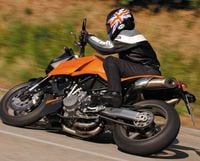

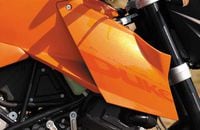
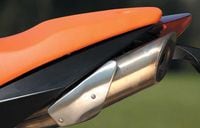

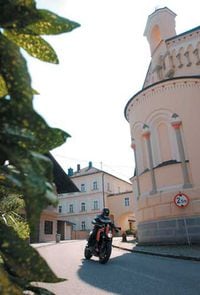
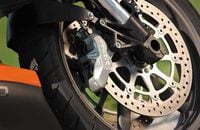
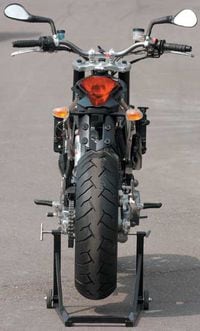


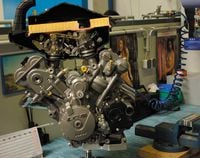

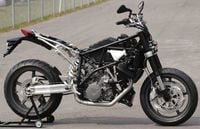
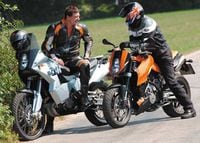
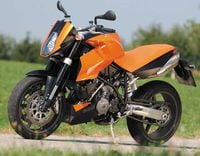
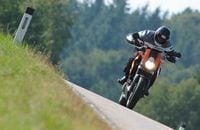

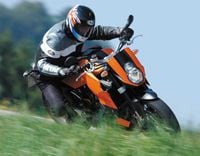
/cloudfront-us-east-1.images.arcpublishing.com/octane/GTCXACQGJ5HAPDTGWUQKDEH44E.jpg)
/cloudfront-us-east-1.images.arcpublishing.com/octane/S35YGSEMEZB4BLTDJTSZPF4GLA.jpg)
/cloudfront-us-east-1.images.arcpublishing.com/octane/5UOT6HPX2JFMRJAX6EH45AR4MQ.jpg)
/cloudfront-us-east-1.images.arcpublishing.com/octane/OKWOJWAKP5EP3OACCRRWPCIX2Q.jpg)
/cloudfront-us-east-1.images.arcpublishing.com/octane/2WF3SCE3NFBQXLDNJM7KMXA45E.jpg)
/cloudfront-us-east-1.images.arcpublishing.com/octane/G4MG6OUCJNBSHIS2MVVOTPX65E.jpg)
/cloudfront-us-east-1.images.arcpublishing.com/octane/IIGGWFOTOJGB7DB6DGBXCCMTDY.jpg)
/cloudfront-us-east-1.images.arcpublishing.com/octane/QSTCM6AVEZA5JJBUXNIQ3DSOF4.jpg)
/cloudfront-us-east-1.images.arcpublishing.com/octane/U4I7G625B5DMLF2DVIJDFZVV6M.jpg)
/cloudfront-us-east-1.images.arcpublishing.com/octane/B6XD6LS6IVCQPIU6HXDJSM3FHY.jpg)
/cloudfront-us-east-1.images.arcpublishing.com/octane/ICL63FEDDRDTTMINYICCEYGMDA.jpg)
/cloudfront-us-east-1.images.arcpublishing.com/octane/FCGZHQXRBZFLBAPC5SDIQLVF4I.jpg)
/cloudfront-us-east-1.images.arcpublishing.com/octane/WNOB6LDOIFFHJKPSVIWDYUGOPM.jpg)

/cloudfront-us-east-1.images.arcpublishing.com/octane/X33NU3E525ECRHXLNUJN2FTRKI.jpg)
/cloudfront-us-east-1.images.arcpublishing.com/octane/6KKT5NNL2JAVBOXMZYS5ZO76YA.jpg)
/cloudfront-us-east-1.images.arcpublishing.com/octane/J5RKG5O455GMPGQRF2OG6LRT7A.jpg)
/cloudfront-us-east-1.images.arcpublishing.com/octane/GX2CIZKQVRH2TATDM26KFG2DAE.jpg)
/cloudfront-us-east-1.images.arcpublishing.com/octane/ZWIDYSAKQZHD5BHREMQILXJCGM.jpg)
/cloudfront-us-east-1.images.arcpublishing.com/octane/CYUHJZCTSJCH3MRAQEIKXK7SCQ.jpg)
/cloudfront-us-east-1.images.arcpublishing.com/octane/LKOFINY56FCXJCANJ5M7ZDQUBY.jpg)
/cloudfront-us-east-1.images.arcpublishing.com/octane/4NBPDACMWJH63JQYJVK3QRBDZI.jpg)
/cloudfront-us-east-1.images.arcpublishing.com/octane/KKHQHRR3FJGX7H2IPU6RALMWG4.jpg)
